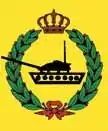3rd Armored Division (Jordan)
The King Abdullah II 3rd Armored Division (Arabic:3 فرقة الملك عبدالله الثاني المدرعة) is a former armored division[1] in Jordanian Armed Forces and it was equipped and trained for high intensity combat operations against militarily organized enemies as well as peacekeeping missions, the division was deactivated in 2018.
| King Abdullah II 3rd Armored Division | |
|---|---|
| فرقة الملك عبدالله الثاني المدرعة 3 الملكية | |
 3rd Royal Armored Division insignia | |
| Active | 1969–2018 (Deactivated) |
| Country | Jordan |
| Branch | Jordanian Armed Forces |
| Type | Division |
| Role | Conventional warfare, peacekeeping |
| Size | ~ 15,000 (2012 est.) |
| Garrison/HQ | Amman, Al-Muwaqqar |
| Colors | KA2 Desert Digital |
| Engagements | |
| Commanders | |
| Current commander | Brigadier General Jumah T. Alhrout |
History
The 3rd Armored Division was formed in 1969.
The Division functions as the Jordanian strategic reserve and it is deployed between Zarqa, to the northeast of Amman to Qatraneh in the south on the way to Saudi Arabia.[1][2][3][4][5][6]
Since Qatraneh has a strategic position vis-a-vis the attack routes along the Dead Sea, the 40th Armored Brigade was usually based there.[4][5]
Kenneth Pollack, a U.S. military analyst, wrote in c.2002 that 'from 1948 to 1956, the Arab Legion was far superior to any of the other Arab militaries. In battle, it generally gave as good as it got, and the Israelis considered it their most dangerous adversary. However, after 1956, the Jordanian capabilities began to decline. In 1967 they performed worse than in 1948, although the exceptional performance of the 40th Armoured Brigade and a number of Israeli mistakes helped disguise the deterioration somewhat. Thereafter Jordanian capabilities continued to gradually erode.'[7]
In the 1973 Yom Kippur War, the 40th Armoured Brigade was sent to the Syrian front and played a significant role in the fighting.
King Abdullah II became Battalion Commander of the Second Royal Armored Battalion – 40th Armored Brigade in January 1992. In 1993, he was in the 40th Armored Brigade with the rank of Colonel.[5]
This Division was involved in the 1948 Arab–Israeli War, reprisal operations, the Six-Day War, the Battle of Karameh, the War of Attrition, Black September and the Yom Kippur War.
In 2018, the 3rd Armored Division HQ with many support units and one armored brigade (91st) has been deactivated, the remaining two armored brigades (40th, 60th) and some units merged with Jordanian Central Command.
Organisation
The Division is deployed between Zarqa, to the northeast of Amman to Qatraneh in the south on the way to Saudi Arabia.[1][2][5]
Units
- Division Command HQ – (Deactivated in 2018)
- 3rd Royal Communication Group – (merged with Central Command Communication Group in 2018)
- Field Reconnaissance Battalion (Army Knights) – (Transferred to Directorate of Joint Military Operations)
- King Hussein 40th Armored Brigade – (Transferred to Central Command in 2018)
- Brigade HQ
- Signal Company
- Prince Hussein bin Abdullah II 1st Armored Infantry Battalion (IFV)
- 2nd Royal Tank Battalion
- Prince Ali bin Al Hussein 4th Tank Battalion
- Services Companies
- Medical Company
- Brigade Maintenance Workshop
- Prince Hassan 60th Armored Brigade – (Transferred to Central Command in 2018)
- Brigade HQ
- Signal Company
- Royal Guard 3rd Armored Infantry Battalion (IFV)
- 3rd Royal Tank Battalion
- 5th Royal Tank Battalion
- Services Companies
- Medical Company
- Brigade Maintenance Workshop
- 91st Royal Armored Brigade – (Deactivated in 2018)
- Brigade HQ
- Signal Company
- King Ali 5th Armored Infantry Battalion (IFV) - (Transferred to Central Command in 2018)
- 10th Royal Tank Battalion
- 11th Royal Tank Battalion
- Services Companies
- Medical Company
- Brigade Maintenance Workshop
- Division Artillery – (Merged with Central command in 2018)
- Division Artillery HQ
- 2nd SP Artillery Battalion
- 7th SP Artillery Battalion
- 23rd SP Artillery Battalion
- 24th Heavy Artillery Battalion (Deactivated in 2018)
- 3rd Royal Field AD Group – (Merged with Central Command in 2018)
- Group HQ
- Signal Company
- 4th Field AD Battalion (Transferred to Southern Command in 2018)
- 73rd Field AD Battalion
- Division Engineer Battalion (Merged with Central command in 2018)
- Supply & Transport Battalion (Merged with Central command in 2018)
- Administrative Transport Group – (Deactivated in 2018)
- Medical Support Group – (Merged with Central command in 2018)
- Construction Group – (Deactivated in 2018)
- Maintenance Group – (Merged with Central command in 2018)
- Division Training Center – (Deactivated in 2018)
Unit summary
References
- Bligh, Alexander (2001). "The Jordanian Army: Between Domestic and External Challenges" (PDF). Middle East Review of International Affairs. 5 (2). Archived from the original (PDF) on 2013-10-14. Retrieved 2013-05-30.
- Rubin, Barry M; Keaney, Thomas A (2002). Armed Forces in the Middle East: Politics and Strategy. ISBN 978-0-7146-5255-9.
- http://www.janes.com/extracts/extract/emedsu/jords100.html
- "Jordan" (PDF). Archived from the original (PDF) on 2014-12-15. Retrieved 2013-04-17.
- "ihracat.ssm.gov.tr" (PDF). Archived from the original (PDF) on 2009-11-22. Retrieved 2013-05-14.
- IISS Military Balance 2004–2005, p.127-128
- Kenneth Pollack, Arabs at War, Council on Foreign Relations/University of Nebraska Press, 2002, p.355